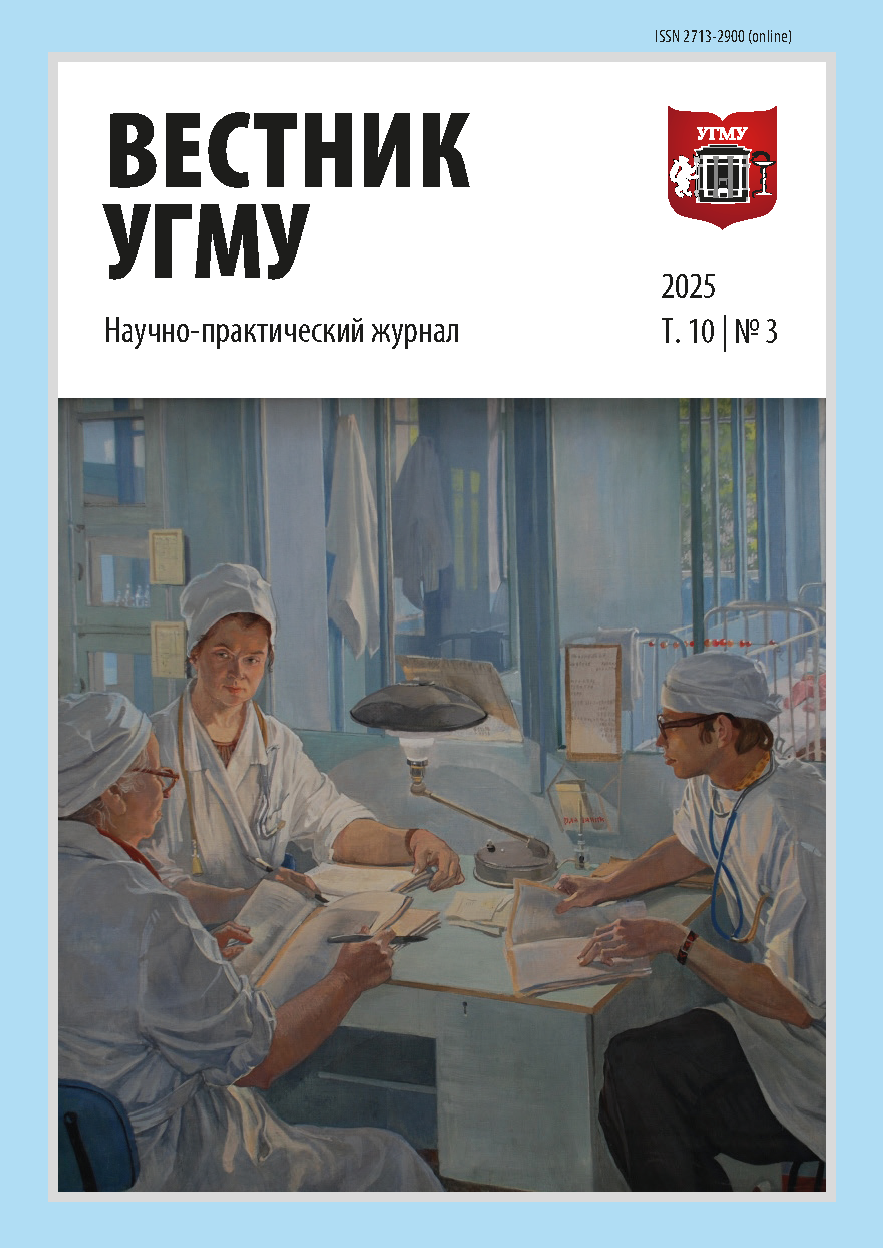Abstract
Introduction. Risk factors for transient ischemic attacks (TIA) in adolescence remain understudied. The aim of the work is to analyze laboratory and instrumental examination results of patients who have had a TIA episode and identify possible risk factors for the development of the disease.
Materials and methods. A retrospective assessment of medical records of 104 children aged 10 to 17 years who had a TIA episode was performed, with analysis and interpretation of laboratory and instrumental parameters.
Results and discussion. The results of the study revealed the presence of features and/or anomalies in the structure of the cerebrovascular bed in every third child (35.2 %), heart rhythm and conduction disorders in 28.2 % of patients. Changes in the blood system were demonstrated: 37.4 % of cases of erythrocytosis, which can be considered a sign of hemoconcentration; signs of dyslipidemia (36.5 %) and hyperhomocysteinemia (56.4 %). Analysis of the carriage of single nucleotide polymorphisms of the genes of the procoagulant and prothrombotic spectrum showed that a total of 64.5% of children were found to be carriers of more than 5 single nucleotide substitutions. In 60.6 % of patients, 3 or more risk factors for TIA were found, which allows us to establish the most probable pathogenetic mechanism of its development, while in 34 patients (32.7 %) 1 and 2 risk factors were found, in 7 patients (6.7 %) they were not found, which requires a more in-depth search and a comprehensive scope of examinations to identify all possible causes and mechanisms of TIA development.
Conclusions. Children who have had TIA require a comprehensive laboratory and instrumental examination to verify the causes of the acute vascular event and determine the most probable pathogenetic model of the disease.
For citation
Gorodnicheva AV, Lvova OA, Orlova EA, Sulimov AV, Kovalenko SD, Berdyugin IN, et al. Transient ischemic attacks in adolescence: Risk factor peculiarities. USMU Medical Bulletin. 2025;10(3):e00171. (In Russ.). DOI: https://doi.org/10.52420/usmumb.10.3.e00171. EDN: https://elibrary.ru/DBGZCW.
References
Агафонов КИ, Трясунова МА, Горбатенко ОА, Гуркина ИВ. Экономические аспекты лечения больных с острым нарушением мозгового кровообращения. Смоленский медицинский альманах. 2016;(1):11–15. [Agafonov KI, Tryasunova MA, Gorbatenko OA, Gurkina IV. Economical spects of treatment of patients with stroke. Smolenskij medicinskij al’manah. 2016;(1):11–15. (In Russ.)]. EDN: https://elibrary.ru/VWZXTT.
Министерство здравоохранения Российской Федерации. Ишемический инсульт и транзиторная ишемическая атака: клинические рекомендации. 2024. 385 с. [Ministry of Health of the Russian Federation. [Ischemic stroke and transient ischemic attack: Clinical recommendations]. 2024. 385 p. (In Russ.)]. Available from: https://clck.ru/3NsHk2 (accessed 1 March 2025).
Wessel N, Sprincean M, Sidorenko L, Revenco N, Hadjiu S. Pediatric ischemic stroke: Clinical and paraclinical manifestations — algorithms for diagnosis and treatment. Algorithms. 2024;17(4):171. DOI: https://doi.org/10.3390/a17040171.
Львова ОА, Орлова ЕА, Гаврилов ИВ, Гусев ВВ, Партылова ЕА, Черешнев КИ, и др. Транзиторные ишемические атаки, дебютирующие в детском и молодом возрасте: факторы риска и подходы к терапии. Уральский медицинский журнал. 2016;(4):35–40. [Lvova ОА, Orlova ЕА, Gavrilov IV, Gusev VV, Partylova EA, Chereshnev KI, et al. Transient ischemic attack in childhren and young: Risk factors and therapy approaches. Ural Medical Journal. 2016;(4):35–40. (In Russ.)]. EDN: https://elibrary.ru/WELQDN.
Lehman LL, Watson CG, Kapur K, Danehy AR, Rivkin MJ. Predictors of stroke after transient ischemic attack in children. Stroke. 2016;47(1):88–93. DOI: https://doi.org/10.1161/STROKEAHA.115.009904.
Львова ОА. Ишемические инсульты и транзиторные ишемические атаки у детей: клинические и молекулярно-генетические аспекты течения, прогнозирование исходов, тактика динамического наблюдения: дис. … д-ра мед. наук. Екатеринбург; 2017. 249 с. [Lvova OA. [Ischemic strokes and transient ischemic attacks in children: clinical and molecular genetic aspects of the course, prediction of outcomes, tactics of dynamic observation: Diss. … Dr. Sci. (Med.)]. Ekaterinburg; 2017. 249 p. (In Russ.)]. EDN: https://elibrary.ru/CXBCPY.
Sinclair AJ, Fox CK, Ichord RN, Almond CS, Bernard TJ, Beslow LA, et al. Stroke in children with cardiac disease: Report from the International Pediatric Stroke Study Group Symposium. Pediatric Neurology. 2015;52(1):5–15. DOI: https://doi.org/10.1016/j.pediatrneurol.2014.09.016.
Леонова ЕВ, Чантурия АВ, Висмонт ФИ. Патофизиология системы крови: учеб. пособие. 2-е изд., испр. и доп. Минск: Вышэйшая школа; 2013. 144 с. [Leonova EV, Chanturia AV, Vismont FI. [Pathophysiology of the blood system: textbook. 2nd ed., rev. and exp.]. Minsk: Higher school; 2013. 144 p. (In Russ.)].
Leniček Krleža J, Ðuranović V, Bronić A, Coen Herak D, Mejaški-Bošnjak V, Zadro R. Multiple presence of prothrombotic risk factors in Croatian children with arterial ischemic stroke and transient ischemic attack. Croatian Medical Journal. 2013;54(4):346–354. DOI: https://doi.org/10.1016/10.3325/cmj.2013.54.346.
Львова ОА, Гусев ВВ, Ковтун ОП, Гаврилов ИВ, Решетова АН, Степанова АЭ, и др. Детский ишемический инсульт: вклад полиморфизма генов фолатного цикла и гипергомоцистеинемии. Сибирский медицинский журнал. 2013;28(3):34–40. [Lvova OA, Gusev VV, Kovtun OP, Gavrilov IV, Reshetova AN, Stepanova AE, et al. Ischemic stroke in children: The role of folate pathway genetic polymorphisms and hyperhomocysteinemia. Siberian Medical Journal. 2013;28(3):34–40. (In Russ.)]. EDN: https://elibrary.ru/TUJJJX.
Najib N, Magin P, Lasserson D, Quain D, Attia J, Oldmeadow C, et al. Contemporary prognosis of transient ischemic attack patients: A systematic review and meta-analysis. International Journal of Stroke. 2019;14(5):460–467. DOI: https://doi.org/10.1177/1747493018823568.
Ois A, Zabalza A, Moreira A, Cuadrado-Godia E, Jimenez-Conde J, Giralt-Steinhauer E, et al. Long-term cardiovascular prognosis after transient ischemic attack: Associated predictors. Neurology. 2018;90(7):553–558. DOI: https://doi.org/10.1212/WNL.0000000000004965.
This work is licensed under a Creative Commons Attribution-NonCommercial-ShareAlike 4.0 International License
Copyright © 2025 Gorodnicheva A. V., Lvova O. A., Orlova E. A., Sulimov A. V., Kovalenko S. D., Berdyugin I. N., Mezhiritskaya M. S., Sergeev A. P.





